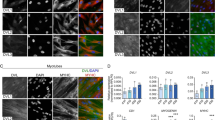Abstract
Objective
Pax3 and Pax7 are closely related genes that are involved in commitment of cells to a myogenic lineage during skeletal muscle development and regeneration. Several Pax3 and Pax7 transcripts are expressed from the genes, generating different isoforms with potentially distinct DNA binding and transactivation properties. The aim of this study was to investigate the implication of Pax3 and Pax7 C-terminal isoforms during myogenic differentiation and tumorigenesis, since fusions involving these genes are commonly associated with alveolar rhabdomyosarcoma (ARMS).
Methods
Uncommitted (mouse mesenchymal stem cells, MSCs) and committed (C2C12) myogenic precursor cells were stably transfected with PAX3/FKHR and PAXC7/FKHR fusion genes. We analysed gene and protein expression comparing the newly generated cells with the parental cells, to determine the functional importance of Pax3 and Pax7 C-terminal isoforms.
Results
We found that the transcript Pax3c was expressed at low levels in undifferentiated C2C12 and MSCs cells, but its expression levels increased considerably at later stages of differentiation. However, expression levels of Pax3d transcript increased only slightly after differentiation. Pax7 transcripts, present before differentiation in committed C2C12 cells, but absent in uncommitted MSCs, increased noticeably in MSCs after differentiation. We also found that the presence of PAX/FKHR fusions prevented both C2C12 and MSC cells from terminal myogenic differentiation and increased the expression of discrete endogenous Pax3/7 transcripts, in particular Pax3d and Pax7B. Conclusions Our results suggest that both Pax3 and Pax7 transcripts are required for commitment of cells to the myogenic lineage, with each transcript having a distinct role. More specifically, the Pax3c isoform may be required for terminal myogenic differentiation whereas the Pax3d isoform may be involved in undifferentiated cell maintenance and/or proliferation.
Similar content being viewed by others
References
Chi N, Epstein JA (2002) Getting your Pax straight: Pax proteins in development and disease. Trends Genet 18:41–47
Mikkola I, Bruun JA, Bjorkoy G et al (1999) Phosphorylation of the transactivation domain of Pax6 by extracellular signal-regulated kinase and p38 mitogen-activated protein kinase. J Biol Chem 274:15115–15126
Underhill DA, Gros P (1997) The paired-domain regulates DNA binding by the homeodomain within the intact Pax-3 protein. J Biol Chem 272:14175–14182
Lamey TM, Koenders A, Ziman M (2004) Pax genes in myogenesis: alternate transcripts add complexity. Histol Histopathol 19:1289–1300
Vogan KJ, Underhill DA, Gros P (1996) An alternative splicing event in the Pax-3 paired domain identifies the linker region as a key determinant of paired domain DNA-binding activity. Mol Cell Biol 16:6677–6686
Ziman MR, Fletcher S, Kay PH (1997) Alternate Pax7 transcripts are expressed specifically in skeletal muscle, brain and other organs of adult mice. Int J Biochem Cell Biol 29:1029–1036
White RB, Ziman MR (2008) Genome-wide discovery of Pax7 target genes during development. Physiol Genomics 33:41–49
Du S, Lawrence EJ, Strzelecki D et al (2005) Coexpression of alternatively spliced forms of PAX3, PAX7, PAX3-FKHR and PAX7-FKHR with distinct DNA binding and transactivation properties in rhabdomyosarcoma. Int J Cancer 115:85–92
Barr FG, Fitzgerald JC, Ginsberg JP et al (1999) Predominant expression of alternative PAX3 and PAX7 forms in myogenic and neural tumor cell lines. Cancer Res 59:5443–5448
Pritchard C, Grosveld G, Hollenbach AD (2003) Alternative splicing of Pax3 produces a transcriptionally inactive protein. Gene 305:61–69
Parker CJ, Shawcross SG, Li H et al (2004) Expression of PAX 3 alternatively spliced transcripts and identification of two new isoforms in human tumors of neural crest origin. Int J Cancer 108:314–320
Wang Q, Kumar S, Slevin M et al (2006) Functional analysis of alternative isoforms of the transcription factor PAX3 in melanocytes in vitro. Cancer Res 66:8574–8580
Barber TD, Barber MC, Cloutier TE et al (1999) PAX3 gene structure, alternative splicing and evolution. Gene 237:311–319
Yaffe D, Saxel O (1977) A myogenic cell line with altered serum requirements for differentiation. Differentiation 7:159–166
Wakitani S, Saito T, Caplan AI (1995) Myogenic cells derived from rat bone marrow mesenchymal stem cells exposed to 5-azacytidine. Muscle Nerve 18:1417–1426
Pittenger M, Vanguri P, Simonetti D et al (2002) Adult mesenchymal stem cells: potential for muscle and tendon regeneration and use in gene therapy. J Musculoskelet Neuronal Interact 2:309–320
Charytonowicz E, Cordon-Cardo C, Matushansky I et al (2009) Alveolar rhabdomyosarcoma: is the cell of origin a mesenchymal stem cell? Cancer Lett 279:126–136
Gang EJ, Bosnakovski D, Simsek T et al (2008) Pax3 activation promotes the differentiation of mesenchymal stem cells toward the myogenic lineage. Exp Cell Res 314:1721–1733
Wannenes F, Caprio M, Gatta L et al (2008) Androgen receptor expression during C2C12 skeletal muscle cell line differentiation. Mol Cell Endocrinol 292:11–19
Blake JA, Ziman MR (2005) Pax3 transcripts in melanoblast development. Dev Growth Differ 47:627–635
de Alava E, Ladanyi M, Rosai J et al (1995) Detection of chimeric transcripts in desmoplastic small round cell tumor and related developmental tumors by reverse transcriptase polymerase chain reaction. A specific diagnostic assay. Am J Pathol 147:1584–1591
Graf Finckenstein F, Shahbazian V, Davicioni E et al (2008) PAX-FKHR function as pangenes by simultaneously inducing and inhibiting myogenesis. Oncogene 27:2004–2014
Czerny T, Schaffner G, Busslinger M (1993) DNA sequence recognition by Pax proteins: bipartite structure of the paired domain and its binding site. Genes Dev 7:2048–2061
Vogan KJ, Gros P (1997) The C-terminal subdomain makes an important contribution to the DNA binding activity of the Pax-3 paired domain. J Biol Chem 272:28289–28295
Wang Q, Fang WH, Krupinski J et al (2008) Pax genes in embryogenesis and oncogenesis. J Cell Mol Med 12:2281–2294
Deneen B, Denny CT (2001) Loss of p16 pathways stabilizes EWS/FLI1 expression and complements EWS/FLI1 mediated transformation. Oncogene 20:6731–6741
Xia SJ, Barr FG (2004) Analysis of the transforming and growth suppressive activities of the PAX3-FKHR oncoprotein. Oncogene 23:6864–6871
Vorobyov E, Horst J (2004) Expression of two protein isoforms of PAX7 is controlled by competing cleavage-polyadenylation and splicing. Gene 342:107–112
Author information
Authors and Affiliations
Corresponding author
Rights and permissions
About this article
Cite this article
Charytonowicz, E., Matushansky, I., Castillo-Martin, M. et al. Alternate PAX3 and PAX7 C-terminal isoforms in myogenic differentiation and sarcomagenesis. Clin Transl Oncol 13, 194–203 (2011). https://doi.org/10.1007/s12094-011-0640-y
Received:
Accepted:
Published:
Issue Date:
DOI: https://doi.org/10.1007/s12094-011-0640-y




